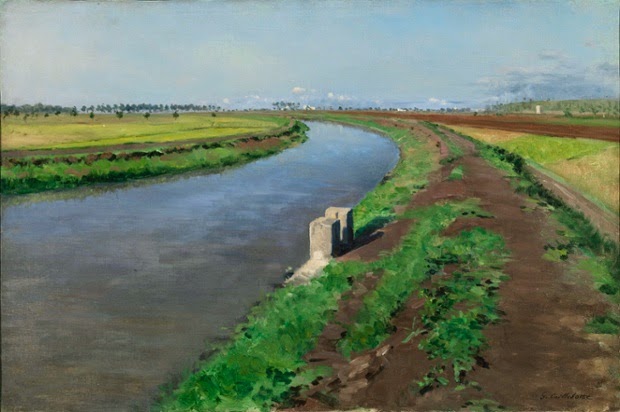Heaney's Banks of a Canal, somewhat banally titled, is an exemplar of great art. It responds to a painting in the most sensual manner. The sonic beauty loaded into every line, the relentless streams of images, surprising if not startling. A casual reader is invited to stroll along the canal, sharing footsteps, breaths and thoughts with the poet.
This is what great art does: awaken the possibility of beauty, sparking a kernel of interest, touching, invading, even molesting. It upturns the staleness of existence, brings forth a fresh drizzle, clears layers of dirt and dust. A canal doesn't just facilitate the movement of water; it prompts the hesitant footsteps of one's thoughts, inviting meditations.
Painting and poetry, the best of them refracts life, love, loss. They touch even when one resists touching, even when one has hardened into a shiny piece of cold ore. They leave their imprints. It's a pleasure to be so influenced, to be brought to life in such a dangerous manner. Seeing the same with renewed eyes, seeing the familiar anew, it's strange. Weeds, insistent, sprouting, pots of coals, demanding to be felt. A journey about a water source or a reflection about one's thinking.
Banks of a Canal
by Seamus Heaney
Gustave Caillebotte, c.1872
Say ‘canal’ and there’s that final vowel
Towing silence with it, slowing time
To a walking pace, a path, a whitewashed gleam
Of dwellings at the skyline. World stands still.
The stunted concrete mocks the classical.
Water says, ‘My place here is in dream,
In quiet good standing. Like a sleeping stream,
Come rain or sullen shine I’m peaceable.’
Stretched to the horizon, placid ploughland,
The sky not truly bright or overcast:
I know that clay, the damp and dirt of it,
The coolth along the bank, the grassy zest
Of verges, the path not narrow but still straight
Where soul could mind itself or stray beyond.
This is what great art does: awaken the possibility of beauty, sparking a kernel of interest, touching, invading, even molesting. It upturns the staleness of existence, brings forth a fresh drizzle, clears layers of dirt and dust. A canal doesn't just facilitate the movement of water; it prompts the hesitant footsteps of one's thoughts, inviting meditations.
Painting and poetry, the best of them refracts life, love, loss. They touch even when one resists touching, even when one has hardened into a shiny piece of cold ore. They leave their imprints. It's a pleasure to be so influenced, to be brought to life in such a dangerous manner. Seeing the same with renewed eyes, seeing the familiar anew, it's strange. Weeds, insistent, sprouting, pots of coals, demanding to be felt. A journey about a water source or a reflection about one's thinking.
 |
| Banks of a Canal, near Naples, c 1872 by Gustave Caillebotte. Photograph: National Gallery of Ireland |
by Seamus Heaney
Gustave Caillebotte, c.1872
Say ‘canal’ and there’s that final vowel
Towing silence with it, slowing time
To a walking pace, a path, a whitewashed gleam
Of dwellings at the skyline. World stands still.
The stunted concrete mocks the classical.
Water says, ‘My place here is in dream,
In quiet good standing. Like a sleeping stream,
Come rain or sullen shine I’m peaceable.’
Stretched to the horizon, placid ploughland,
The sky not truly bright or overcast:
I know that clay, the damp and dirt of it,
The coolth along the bank, the grassy zest
Of verges, the path not narrow but still straight
Where soul could mind itself or stray beyond.
Comments
Post a Comment